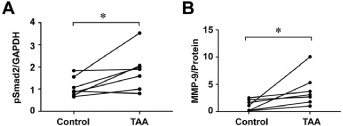1.Research Summary
The Department of Cardiovascular and Respiratory Surgery is divided into the Respiratory Surgery Group and the Cardiovascular Surgery Group and both groups conduct highly technical research. Basic research that aims at clinical application and is common to both groups is also conducted.
2.Research Groups
3-1.Respiratory Surgery Group
Research subjects
3-2.Cardiovascular Surgery Group
Research subjects
4.Research results
[Area] Respiratory surgery
[Research subject]
Molecular pathology of lung cancer
[Description]
The downstream pathways of receptor tyrosine kinase (RTK) are involved
in the regulation of cell proliferation, migration, infiltration, and apoptosis,
and play a very important role in carcinogenesis. Mainly three pathways,
the Ras/Raf/ERK, PI3K/AKT, and Jak/Stat3 pathways, are considered to be
involved. We have thus far reported that the PI3K/AKT pathway becomes more
activated than the Ras/Raf/ERK pathway as the disease stage progresses
in lung adenocarcinoma and that the phosphorylated protein expression of
AKT serves as a prognostic factor. We are investigating the association
of adenocarcinoma in situ (AIS) with normal adenocarcinoma in terms of
habitual smoking and receptor tyrosine kinase expression. We have accumulated
data suggesting that AIS is not the origin of adenocarcinoma.
[Photographs]
Pathway of receptor tyrosine kinase
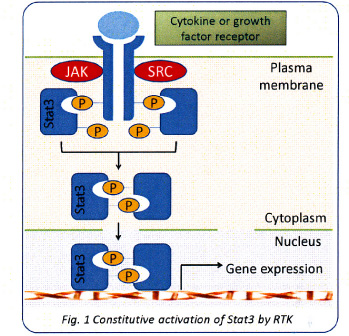
AIS and phosphorylated protein expression
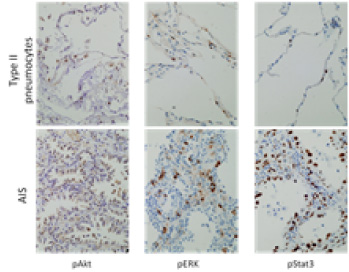
[Area] Cardiovascular and respiratory surgery
[Research subject]
Lung transplantation
[Description]
In lung transplantation, the lung obtained from the donor is refluxed in
preservation solution and cryopreserved before being transplanted into
the recipient, but the allowable ischemic time is limited to approximately
8 hours. In addition, only a small proportion of donated lungs functions
well enough to be transplanted because of liver disorders affecting the
donors.
If obtained lungs can be refluxed and aerated ex vivo to improve lung function
and if storage beyond the allowable ischemic time becomes possible, the
supply of lungs that can be transplanted will increase and an improvement
in transplantation results can be expected.
Therefore, we have been conducting reflux experiments using porcine and
human lungs. Based on our investigations thus far, we have reported that
oxygenation is preserved and anaerobic metabolism increases during reflux
and that the lactic acid/pyruvic acid ratio is useful as a biomarker.
(http://www.ncbi.nlm.nih.gov/pubmed/21930395)
[Photographs]
Porcine and human lungs are refluxed to reduce reperfusion injury
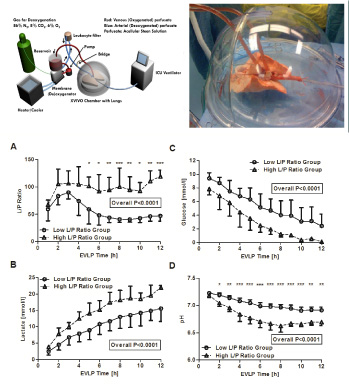
[Area] Cardiovascular surgery
[Research subject]
Gene transfer in transplantation
[Description]
Aortic dissection is a fatal disease with sudden onset, and there are still
a number of cases in which lifesaving is difficult despite the recent progress
in diagnostic treatment. Because aortic dissection is believed to develop
based on weakening of the vascular wall, stress-responsive signal molecules
associated with inflammation and extracellular matrix metabolism are possibly
involved. We focused on c-Jun N-terminal kinase (JNK) and investigated
how JNK and its isoforms (JNK1 and JNK2) are involved in the pathogenesis
of aortic dissection. Based on the results of animal studies and culture
experiments using human aortic wall specimens, we elucidated that JNK activation
plays an important role in weakening of the aortic wall and the pathological
mechanism leading to the onset of dissection.
(http://www.sciencedirect.com/
science/article/pii/S0022480412019567)
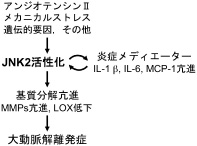
[Photographs]
Localization of pSmad2 and MMP-9 in human TAAs
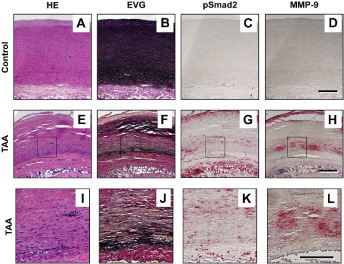
Expression of pSmad2 and MMP-9 in human TAAs.
